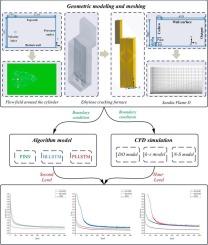New approach of the solution of physical fields of fluid dynamics: Physics-informed long short-term memory network
IF 2.6
3区 工程技术
Q2 ENGINEERING, MECHANICAL
International Journal of Heat and Fluid Flow
Pub Date : 2025-08-28
DOI:10.1016/j.ijheatfluidflow.2025.110024
引用次数: 0
Abstract
The essence of fluid dynamics problems is to solve the nonlinear partial differential equations (PDEs) of the system. Physics-informed neural networks (PINN) have shown significant advantages in solving nonlinear PDEs using a small number of samples. However, they have inherent limitations in capturing long-term dependencies in time series data, which limits the improvement of their predictive performance. To overcome those problems, this study proposes a novel hybrid model − physics-informed long short-term memory (PI-LSTM), which combines PINN with long short-term memory (LSTM) networks, significantly improving the prediction accuracy and model generalization ability of complex dynamic system behavior. The computational fluid dynamics (CFD) is used to obtain multiple physical field datasets at different time points under different operating conditions. PINN is employed to encode the physical constraints in depth, and obtain the internal physical laws of complex dynamic systems in high dimensions. LSTM is used to dynamically adjust the information flow through its dynamic memory controller, the collaborative update mechanism of memory encoder and state representation vector are used to deeply model the correlation across time steps. To enhance the physical consistency of the model, the control equations are embedded in the loss function in the form of a function as a regularization constraint term. Through the iterative learning process of Deep Neural Network (DNN), the network weight parameters are continuously optimized. The results of three numerical cases, i.e., the flow around the cylinder, Sandia flame D, and ethylene cracking furnace, show that the proposed PI-LSTM model improves the prediction accuracy by 57.27% and 56.22%, 55.88% and 58.23%, 56.56% and 65.39% compared to PINN and BI-LSTM, respectively. Compared with CFD methods, PI-LSTM has increased computational efficiency by 1440 times, while reducing storage space requirements by 99.62%. The proposed PI-LSTM model provides a solid technical support for the design and optimization of complex turbulent reaction coupling processes.

流体动力学物理场解的新方法:物理信息长短期记忆网络
流体动力学问题的本质是求解系统的非线性偏微分方程。物理信息神经网络(PINN)在使用少量样本求解非线性偏微分方程方面显示出显着的优势。然而,它们在捕获时间序列数据中的长期依赖关系方面存在固有的局限性,这限制了它们预测性能的提高。为了克服这些问题,本研究提出了一种新的混合模型-物理通知长短期记忆(PI-LSTM),该模型将PINN与长短期记忆(LSTM)网络相结合,显著提高了复杂动态系统行为的预测精度和模型泛化能力。采用计算流体力学(CFD)方法,获取不同工况下不同时间点的多个物理场数据集。利用PINN对物理约束进行深度编码,获得高维复杂动力系统的内部物理规律。利用LSTM通过动态记忆控制器对信息流进行动态调整,利用记忆编码器的协同更新机制和状态表示向量对跨时间步的相关性进行深度建模。为了增强模型的物理一致性,控制方程以正则化约束项的函数形式嵌入到损失函数中。通过深度神经网络(Deep Neural Network, DNN)的迭代学习过程,不断优化网络权重参数。结果表明,PI-LSTM模型与PINN和BI-LSTM模型相比,预测精度分别提高了57.27%和56.22%、55.88%和58.23%、56.56%和65.39%。与CFD方法相比,PI-LSTM计算效率提高了1440倍,存储空间要求降低了99.62%。所提出的PI-LSTM模型为复杂湍流反应耦合过程的设计和优化提供了坚实的技术支持。
本文章由计算机程序翻译,如有差异,请以英文原文为准。
求助全文
约1分钟内获得全文
求助全文
来源期刊

International Journal of Heat and Fluid Flow
工程技术-工程:机械
CiteScore
5.00
自引率
7.70%
发文量
131
审稿时长
33 days
期刊介绍:
The International Journal of Heat and Fluid Flow welcomes high-quality original contributions on experimental, computational, and physical aspects of convective heat transfer and fluid dynamics relevant to engineering or the environment, including multiphase and microscale flows.
Papers reporting the application of these disciplines to design and development, with emphasis on new technological fields, are also welcomed. Some of these new fields include microscale electronic and mechanical systems; medical and biological systems; and thermal and flow control in both the internal and external environment.
 求助内容:
求助内容: 应助结果提醒方式:
应助结果提醒方式:


